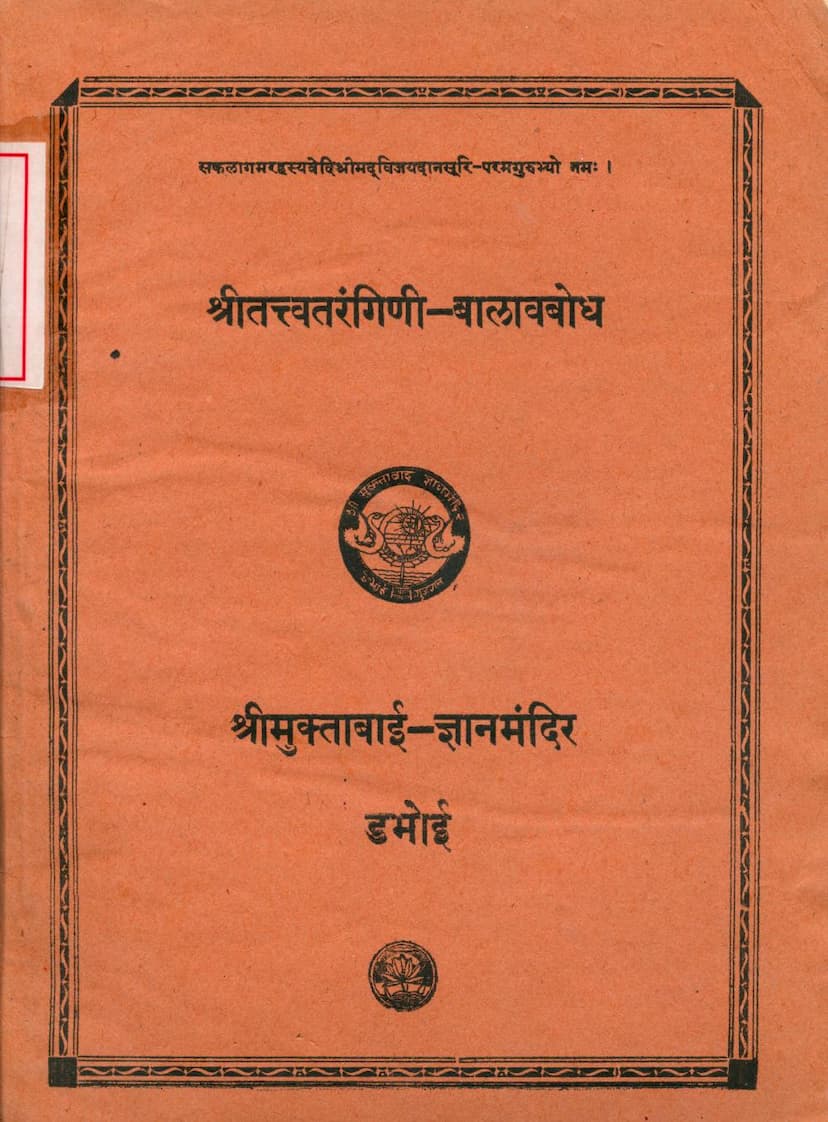Tattva Tarangini Balavbodh
Added to library: September 2, 2025

Summary
This document is the Gujarati translation and commentary of the Jain text "Tattva Tarangini" by Upadhyay Shri Dharmasagarji Ganivar, with a commentary titled "Balavbodh." The text primarily addresses the intricate issues of Tithi Aradhana (worship according to lunar dates) within Jainism, particularly focusing on the practices and beliefs of the Tapagachha lineage.
Here's a comprehensive summary based on the provided pages:
Book Details:
- Title: Shri Tattva Tarangini - Balavbodh (श्री तत्त्वतरंगिणी-बालावबोध)
- Original Author: Upadhyay Shri Dharmasagarji Ganivar (उपाध्याय श्री धर्मसागरजी गणि)
- Commentator/Translator: An unnamed Mahatma of similar time as the original author.
- Language Commentary: Acharya Devesh Shrimad Vijaypremsurishwarji Maharaj (आचार्य देवेश श्रीमद्विजयप्रेम सूरिश्वरजी महाराज) (for contemporary Gujarati translation) and Acharyavar Shri Vijay Jambusurishwarji Maharaj (आचार्यवर श्रीमद्विजय जंबू सूरीश्वरजी महाराज) (for the Balavbodh translation).
- Publisher: Muktabai Gyanmandir, Dabhoi (श्री मुक्ताबाई ज्ञानमंदिर, डभोई)
- Publication Date: Vikram Samvat 2005 (V.S. 2005), corresponding to 1948 CE.
- Purpose: To clarify and establish the correct method of Tithi Aradhana, addressing prevalent misconceptions and debates within the Jain community.
Core Theme and Purpose:
The central purpose of this publication is to refute the incorrect practices and beliefs regarding Tithi Aradhana that had become prevalent. The book specifically tackles the confusion around:
- Uday Tithi vs. Ast Tithi: Whether to observe a ritual on the day the tithi rises or the day it sets.
- Kshaya (Diminution) and Vriddhi (Increase) of Tithis: How to perform rituals when a tithi is shortened or prolonged, and the correct procedure for observing the tithi during festivals like Paryushan.
- The debate on whether to artificially adjust preceding tithis (like thirteen) to align with subsequent tithis (like the fourteenth) when there's a tithi overlap or deficit.
The book strongly advocates for adhering to the original tithi and its natural occurrence, as established in ancient Jain scriptures, and rejects the practice of manipulating tithis to create artificial overlaps or to observe festivals on incorrect dates.
Key Arguments and Content:
-
Historical Context: The introduction explains that the current tithi debates are not new and have roots stretching back decades, if not earlier. The current practice of observing festivals on different days is highlighted as a problem.
-
Rejection of Artificial Adjustments: The text vehemently criticizes the practice of changing preceding tithis (e.g., treating the 13th as the 14th if the 14th is short) or creating fictitious tithi increases. It argues that if such practices were sanctioned by ancient authorities, they would have been explicitly mentioned in the original texts.
-
Emphasis on Original Tithi: The core message is to worship the tithi as it naturally occurs, without artificial alterations. The text cites several verses from the "Tattva Tarangini" to support this view.
-
Exegesis of Key Verses:
- Verses 5-6: These verses are used to demonstrate that when a tithi is diminished, the previous tithi should be followed, and when it is increased, the subsequent tithi should be observed. The practice of observing a tithi on the 13th instead of the 14th due to a perceived shortage of the 14th is strongly condemned.
- Verses 18 & 19: These verses discuss how to handle tithi overlaps. The argument is made that if two tithis complete within one day, that day is considered valid for both. However, it doesn't imply that if a tithi is slightly prolonged into the next day, one should ignore the first day and solely focus on the second. The principle of observing the tithi that fully completes within a day is emphasized.
- Verses 20-21: These verses address the observation of festivals like Paryushan. The text asserts that Paryushan is correctly observed on the 4th tithi (Chaturthi), not the 5th (Panchami) or the full moon (Purnima), as some contemporary interpretations might suggest. It cites scriptures like Saptashati and Kalpasutra to support the observation on the 4th tithi.
- Verses 22-23: These verses discuss the general rules of tithi observation. They clarify that while specific festivals have prescribed tithis (e.g., Ashtami and Chaturthi for specific observances, Chath for Chaturmas, Ashtami for Paryushan), other tithis have flexibility (bhajana or options). The text argues that if a tithi has no prescribed observance, it doesn't automatically imply it should be avoided; rather, it offers flexibility. The concept of "pratinniyat divas" (prescribed day) is interpreted as the actual day a ritual completes, not necessarily the entirety of the tithi.
-
Critique of Misinterpretations: The text addresses common misunderstandings, such as:
- The belief that if a tithi is slightly short, the entire tithi should be considered non-existent.
- The practice of prioritizing the 5th tithi or Purnima for festivals when the scriptures prescribe the 4th tithi.
- The misinterpretation of the phrase "pratinniyat divas" to exclusively mean Chaturthi or Panchami, ignoring other tithis that might be relevant.
-
Scholarly Support: The text refers to other Jain scholarly works and commentaries to validate its interpretations, including references to Mahanishith Sutra, Vyavahar Sutra, and Saptashati. It also quotes interpretations from Acharya Vijay Palsurishwarji and Acharya Buddhisagar Suri to strengthen its arguments.
-
Theological Basis: The foundational principle is that of following the teachings of the Tirthankaras and ancient ācāryas. The text emphasizes that adhering to the natural progression of tithis and the prescribed observances is crucial for spiritual progress and avoiding errors.
Overall Message:
"Tattva Tarangini Balavbodh" serves as a strong defense of established Jain tradition and scripture concerning Tithi Aradhana. It aims to correct deviations from the scriptural norms and guide practitioners towards the correct and meritorious observance of tithis, thereby promoting genuine spiritual practice and unity within the Jain community. The publication is presented as a revival and clarification of ancient wisdom for the benefit of modern devotees.